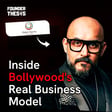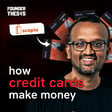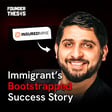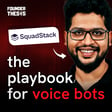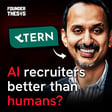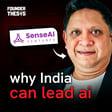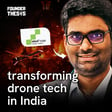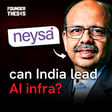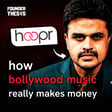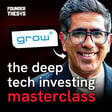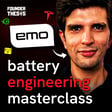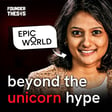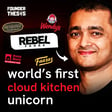Introduction of Mayur Abhay, Founder of LifeSell
00:00:00
Speaker
Hi everyone, this is Mayur Abhay, founder of LifeSell International.
Scaling LifeSell to 800 Crore Revenue
00:00:19
Speaker
Whenever we have featured founders who have scaled their businesses meaningfully, it is typically because they have been good at acquiring customers and increasing their lifetime value. But Mayur Abhay, our guest in this episode, has scaled lifestyle to an annual revenue of about 800 crores on the back of its strong supply chain and delivery capabilities.
Family Entrepreneurship: Shasun Farmaf & Knifecell
00:00:39
Speaker
Mayur's father was a serial entrepreneur in the pharma and healthcare care space and built Shasun Farmaf, a $500 million dollars global pharma manufacturing player. He also set up Knifecell as he saw the gap in the market for stem cell
Diversifying LifeCell's Healthcare Products
00:00:52
Speaker
banking. Mayur joined the business when the top line was just 20 crores and over the last 16 years has expanded the business both geographically and in terms of product lights.
00:01:01
Speaker
Today, just one-fourth of their turnover comes from the original business line of stem cell banking, and some of their business lines are around delivering cutting-edge health care products to the Indian consumer at amazingly affordable prices.
Joining Foundathesis: LifeCell's Foundation History
00:01:12
Speaker
If you care about health tech, then there is no better episode than this for deeper understanding of the space. Stay tuned and subscribe to the Foundathesis podcast with your host, Akshay Dutt. Mayur, welcome to the Foundathesis podcast.
00:01:27
Speaker
you know so you kind of came into LifeCell, which your father had started. I'd love to get a little bit of a historical context on what was it that your father started, what was your background when you came in, ah what what was this company like ah when you started working initially, just a little bit of the pre-journeys you can talk about.
India's First Private Stem Cell Bank
00:01:51
Speaker
Shonakshi, thank you for having me on the show. LifeCell, as a company, started in house at 4.
00:01:58
Speaker
It was India's first private stem cell bank. The company reserves the stem cells from a newborn right after birth and preserves it at minus 200 centigrade so that it remains viable you know until the time there is a medical need.
Expansion into Genomic Testing & Wellness
00:02:16
Speaker
My father was a serial entrepreneur, had started his journey you know about 40 years back as a pharma enterprise entrepreneur.
00:02:27
Speaker
Then has done many other and industries, including visual animation, nanotechnology, and many more. I had joined the company in 2008, almost about four plus years founded.
Father's Ventures & Entrepreneurial Spirit
00:02:44
Speaker
And I had a background in biotechnology. And so there was meant that this was something that I could help expand the company.
00:02:54
Speaker
we oh were funded you know at that time. So, there was a startup capital. What we needed was the growth capital and the offerings. So, from a single category company in 2008, we have now established Life Cell as the country's ah largest selling tissue bank.
00:03:15
Speaker
We do genomic testing also for newborns and pregnancies in the country. We offer additional services such as corporate wellness. We offer fertility type. And we also are the largest exporter of human cells and tissues for treatments globally. OK. Fascinating.
00:03:40
Speaker
oh Your father was running all those businesses in parallel or would he start, sell it, start next or like that?
Funding Sources & Business Growth
00:03:49
Speaker
Tell me a little bit about him. Right now, from the early part, he was, you know, committed to a single company. But then, yeah have you're you're right, you're used to the right path of entrepreneur, not a serial entrepreneur. So he would run some of these ventures in that way. How did he get the capital? but I'm sure when he started, there was no such thing as venture funding.
00:04:12
Speaker
How did he build his website? So he had angel funding. you know So my grandfather had someone whom he recommended, whom he considers as a mentor. He was already involved in in helping new industries establish. ah He provided the seat cap to write a college that my father already ventured into starting this.
00:04:35
Speaker
And he has been, you know, funding our other ventures also as a group, even lifestyle when we started. He was the first provider of initial care. And what are the other ventures in the group? Are they still active?
00:04:49
Speaker
ah So, of course, the businesses continue. We have funds for mergers and acquisitions. you know So today, it is amongst the top 10 pharmaceutical lab manufacturing companies in the country. It's called Strides Pharma. But first of all, it was the Shassoon Pharmaceutical.
00:05:10
Speaker
Okay. Okay. Okay. And what is ah the focus area? What manufacturers, right? ah The ah active ingredients, you know, the powders that go into the tablets and capsules. So we don't see branded products from us, you know, example ibuprofen, which is one of the largest painkillers locally. So that is, we're the world's largest manufacturer that active in
00:05:40
Speaker
Okay, so like a million plus headaches. of wow What the pharma supply chain look like? So you're saying that somewhere in the supply chain there is an active ingredient manufactured. Then it goes to finish dosage manufacturing company, takes the active ingredient and the formulated converts it into tablet capsule, whatever it is the form that the ingredient is used as and then of course goes for branding, packaging and distribution. Okay. And the the active ingredient and manufacture starts with raw chemicals and and then processes it to the manufacture the active
00:06:26
Speaker
so Okay. Is this a business of IP or is it a business of scale and operational excellence? I mean, like, you know, intellectual property and research and stuff like that. Sure. I mean, India is the.
00:06:43
Speaker
world's largest manufacturer of active ingredients. So it is clearly something that requires expertise in chemistry. and There is a lot of innovation because there are hidden barriers, active barriers that ah need to be overcome. Novel processes, even more cost efficiency, reduced pollution, all of that has to be addressed to make a successful entity.
00:07:14
Speaker
Okay, like the active ingredient for ibuprofit, the ingredient per se is not patent protected, but how you make it some of those methods you're saying would be the process, some of the processes would be patent protected. that you And then you need to add chemical engineering skills on top of it, because if you're making some of these chemicals that high volumes you know like in the case of broken it's about 600 tons being made every day. That's the level of throughput so also.
00:07:50
Speaker
And what kind of acquisitions did you do in this, like other active ingredient manufacturers? So ah um one of the largest expansion that I was also directly involved with was acquiring a new asset, which was set up as a provider of ingredients you know to companies in the pre-launch phase. So in the drug discovery phase, they would want companies who have chemistry skills to manufacture them, you know, that will support the regulatory clearance and also the launch quantities. So that was something that we felt would complete the life cycle, you know, where we start not just post launch, which most Indian companies do, we start right at the pre-launch phase.
00:08:42
Speaker
So this pre-learned business, ah what is different there? like yeah Is it that you have to do smaller Smaller mattresses. It starts from a few grams. oh you a way that they They check whether the product is OK to being manufactured you know for initial hundreds of patients to then thousands of patients.
00:09:06
Speaker
well gets commercial. oh go and you know So that is more of an iterative manufacturing process. that dis The core business is more of a scaled factoring process.
00:09:19
Speaker
and i okay um great ah Your revenue is largely from India or what is the split like for the pharma business? right Most ah pharma companies um active ingredients, you know, don't have a significant share of revenue coming from imports. And Shasoon, it used to be more than 70% of revenue would be. And what is typically the competitive advantage of companies in this space of active ingredients? Like, I mean, can anybody just tomorrow invest money and start a business and take away market share? Or are there like some like key competitive advantages or modes?
00:10:04
Speaker
that you can defend your business through. Right. Number one is of course your the process skills, you know, how well you design a process to make it efficient ah so that it is long lasting and not just that you have an initial, you know, uneven pace where it is limited competition to succeed but built to last.
00:10:30
Speaker
And what is also important is to have a good, strong customer base. It's not just dependent on a few key customers across 60, 70 countries that one has the interest. One requires the distribution network process skills and ideally IP barriers also to restrict company.
00:10:57
Speaker
and The IP barrier is on the ingredient itself or on only the process? ah Just on the process itself. Got Are these active ingredients typically all patent free or is there a licensing process? No, but you see, patents the last micro 20 Hertz, you know, there is data innovation all through.
00:11:23
Speaker
majority of the ingredients are ah patent free. You know, today, probably only about 100 new ingredients can get approved locally appear. ah So yes, I mean, most of it is, and that's why, you know, medicines in India are very costly. Okay. Okay. You said that you have an initial honeymoon phase. What contributes to that honeymoon phase? Why do you have a honeymoon phase? So in the US, they have an interesting role, you know, where
00:11:53
Speaker
it is something called as a paragraph 4, you know where if you are the first to file as a ah generic manufacturer of a branded product. Then you get ah a 180 days time window where you're the only exclusive alternative. So that gives you a significant price and volume advantage to break through the market. And this they've created so that there is you know more people incentivized to come and make an alternative to a brand.
00:12:25
Speaker
oh Okay, but this 180 days exclusivity is for the finished product manufacturer, right? That's correct, but ah once and usually there is a tie-in.
00:12:41
Speaker
ah the It rushes so much to file as quickly as possible, and almost like see almost every time. For a finished product, there is always only one manufacturer being paid. And if you're working with that manufacturer, you have time is there.
00:13:00
Speaker
you but um got but Does this industry have a lot of churn? Or once you have a customer, then the customer stays with you but forever? like or Or do customers frequently re-evaluate and contract and give it to other vendors also? and like but there is i mean There is obviously motivation not to sweat vendors.
00:13:21
Speaker
and prices or commercial ah necessity. It is not easy to switch vendors. you know First you need to have vendor with established capacity. Next is also you need to go through a regulatory hurdle, where once you switch manufacturers, you need to show that the vendor who is supplying through the alternate vendor is substantially equivalent you know to the current vendor. So, there is lot of chemistry manufacturing controls you know which will get reviewed before and again it needs to go through an FDA inspection of the alternate. So, it could take about a couple of years you know for somebody even if there is a change intended before it actually gets implemented.
00:14:08
Speaker
okay Fascinating. so they're Very high cost of switching. And multiplied by the number of customers globally, right? I mean, there is 50, 60 different customers, but an active engine, all of them happen both from so many of these. So it's a lot of inspection work also regulatory work, just to support the change.
00:14:29
Speaker
In your P&L, and this will be my last question on this. what is the In that P&L, there will be some cost of your raw materials, some cost of people, some cost of sales marketing, and some cost of compliance, I'm assuming. What does that split look like?
00:14:46
Speaker
and we're the mile like like ah So, the cost of active ingredients in India or the chemical raw materials that want to making this ingredients as the highest usually proportionate of about 40 percent of the finished processing is materials. There is the energy cost also that going to you know roughly energy and the equipment cost you know roughly about another 10 percent.
00:15:14
Speaker
It is a people cost which is about 20 percent and the rest of it is the margin available for the company. What would be like a compliance cost? Like you said, there is an FDA. Compliance costs, of course. When I say people cost, that is largely the fee cost. That would be supporting the compliance, quality testing, and quality of assurance. These are the two large companies. Roughly, you could say about, including R&D, about 5% of the revenue is invested. OK. OK. Understood. OK. So let's move on to lifestyle now. So you haven't.
00:15:53
Speaker
On your LinkedIn, I can see your first stint was the pharma business before you joined Lifesale. When you joined Lifesale, how many branches did it have? What kind of revenue was it doing? ah what was What was it like?
00:16:07
Speaker
I thought ah roughly about 10 plus cities that we were in, largely the metro cities. It was about 20 or more in revenue after five years of operations and positive cash flow ah with a little bit of debt on the books. And what was the idea behind starting life? What was the gap in the market that your father saw that this is an opportunity to win something here?
00:16:35
Speaker
So the whole premise of stem cells is that it is the single starting stem from which all the other and cells and tissues and organs of the body are made. So it has got that inherent tension to regenerate and recreate. And decrease and yeah this was already proven that it worked in the case of blood-related transplants.
00:17:02
Speaker
If somebody who is suffering, ah for example, a blood cancer like a leukemia, lymphoma, myeloma, ah and you know with regular initial like approaches, which is medicines or with chemotherapy, they don't beat the cancer, then the only option available for them is a stem cell transplant.
00:17:26
Speaker
It is more like a computer system reboot, you know, once you have a virus, so can't use an antivirus to kill it off. So do is just format the whole computer, delete the original operating software, reload the original, you know, the drive and then reload it. That's what we do with stem cells. We can give, you know, high dose radiotherapy, wipe out the entire immune cells, but it also kills the cancer cells.
00:17:53
Speaker
and you know take a healthy donor stem cells, infuse it into the patient, and then, you know, start, starts growing and repopulating, which take about, you know, 28 to 45 days for a complete record, then into it. And which is why what is important is to have a matching stem syllabus.
00:18:17
Speaker
you know That's the only way that the rejection can be avoided. Because you know you're thinking about going from zeros i mean know from you know zero cells back to to a healthy body. Any rejection of that really be paid.
00:18:34
Speaker
ah okay And there was no you know there was no you know situation of donors being available in the country. organ donation, tissue donation in the country is extremely behind, you know, despite our huge population. And, you know, that was the thing to solve was, you know, was an opportunity that India is the world's largest birthing country. And you could have these stem cells frozen, which is otherwise being discarded and make them readily available for ah immediate release or transplant. That is how we thought the companies need to be solved, very effective.
00:19:09
Speaker
and there was no bank when we started out space started country's first time so I want to ask a more basic question of what is stem cell? Do adults also have stem cells which can be harvested? or And where do stem cells reside in the body? and all it like Give me a more basic understanding of stem cells. All of us as so individuals carry a reservoir of stem cells, which is dead ah nudged largely i mean across the body, but the largest single source is in the bone marrow, which is in the region behind.
00:19:47
Speaker
And, you know, that's where these cells then get reduced, knocked large quantities, which then is carried through the bloodstream across. And every day, you know, ah millions of cells get regenerated in our body. So, and depending on the need, you know, turn into the required ah tissue, you know, long liver tissue, heart, whatever it is required.
00:20:12
Speaker
the and patients who have not stored their own stem cells you know at birth the the obvious alternate and there thus are sort of few indications though very few you know about 80 plus conditions that today get treated with stem cells only birth 78 can get treated using your own stem cells.
00:20:32
Speaker
Also, like multiple myeloma, Lisa, the celebrity actress, she had this condition. you know She didn't need, thankfully, a donor. She could take out her stem cells, you preserve it, get the chemo, radiotherapy, wipe out the cancer, and then infuse her own cells.
00:20:52
Speaker
ah So stem cells can be harvested from adults also. it's not With age, the quality and quantity of cell decrease, you know, which is why and for a patient, you know, most donors are only sourced in the age group of 25. Okay. My understanding of stem cells as an outsider was
00:21:13
Speaker
When your child is born, is when you harvest the stem cells and preserve them. ah and Most pristine cells, right, the fastest growing cells, you know, easy to match. You don't need a complete match compared to an adult.
00:21:29
Speaker
good Like blood group matching, you know have something called as immune group matching or HLA typing technique. um you know Those are about 10 parameters you know and and unlike a blood group which has only blood positive and negative, we have thousands of variations in each of those parameters. So it is ah for you know a much higher order degree of challenge.
00:21:52
Speaker
Thankful with cod blood, even 6 out of 10 parameters match, one could progress with the transplant. A partial match is suited. Unlike an adult, don't know where you need a complete full match. And what is cod blood? Cod blood is where the newborn baby's umbilical cord blood, in short, we call it as cod blood. And that is a source, a rich source of stem cells. A rich source, I mean, which is otherwise being discarded.
00:22:18
Speaker
and about 80 ml of blood can be collected without any pain to the mother or the child. This is after the umbilical cord is cut on both sides. It is glamped and that's when the collection of stem cells happens. It is from the hospital room taken to our lab ah through air logistics. you know Less than 48 hours across the country, we are able to bring in samples to our central lab in Chennai. That's where the stem cells are harvested and then frozen down.
00:22:50
Speaker
We also have a backup storage facility in Gurgaon. Therefore, we have disaster recovery situation where should any one unit be destroyed for whatever reasons, you know beyond our control, we still have a problem.
00:23:03
Speaker
good Today, I'm happy to shame that we have a huge repository of stem cells, um you know more than 90,000 plus units, which are readily available for use for a patient with a 96% chance of finding a match for an Indian origin donor. I think we have largely solved the problem of finding a matching donor for Indian patients. Okay.
00:23:30
Speaker
Is it monetized? by finding people who need themselves that they are charged or is it monetized by charging benefits for preserving stem cells of their babies. Probably it's a mix of both, but just want to understand how that happens.
00:23:51
Speaker
There are two operating models. you know One is like a prepaid, like with the parents for it right at the time of birth, so that when they have a medical need, they don't need to pay anything more, you know including there is a 20 lakh stem cell insurance also with transplants. So a low initial fee with a low recurring fee, this helps not just the child who stem cells are preserved but also the parents and the grandparents of and also of course the siblings so provides a comprehensive cover for you know whole family unit plus medical insurance also is there.
00:24:31
Speaker
You know, for those who have not had the opportunity of preserving their families themselves, it can go, you know, to a public bank, you know, like a regular blood bank, you could have public themselves banks. If finding a matching donor, will today we'll have to pay about 20 lakh rupees. We'll just withdraw a matching. The fourth one can pay and buy a unit. You know, today,
00:24:57
Speaker
Public essential banks you know put together do not have more than 10,000 units. So the probability of finding a match is extremely low in its banks. How many units do you have? ah We have about half a million units preserved with us with about 90,000 plus ready for use, which are matching and meeting the qualification criteria for it all.
00:25:21
Speaker
What is the drop-off between 500,000 and 90,000? There is one a consent required from parents you know to make it available for a third-party use. They are making their child's best themselves.
00:25:37
Speaker
um you know contributing to a community so that if they are sharing they also likewise get a opportunity to withdraw stem cells. There is of course a small proportion of units and because of you know early ah preterm birth you know the quantity of stem cells are not sufficient you know to meet the transplant requirements. Some of the units may also get rejected because of ah contamination like micro contamination largely in the case of um normal vaginal births.
00:26:05
Speaker
okay Okay. And there is also infection diseases testing that is done between the mother and you know so that any HIV, CVA, all those conditions also you know we want to ensure that is not transmitted because of the what is harbored in the mother. Okay. Got it. guard ah from what I understand bulk of the revenue is the At the time of birth, a parent would be charged for storage so ra and being able to use it later in life. But when somebody is coming in to get stem cells, ah that is also monetized.
00:26:45
Speaker
but No, we don't operate as a public mind. So, it is only for members who have preserved their stem cells to us. It's only accessible by them for a transplant, kind of a closed community. Okay, okay. So, therefore, there is the incentive to contribute AV stem cells at work. Yeah, right, right, right, right. Okay.
00:27:10
Speaker
And this would be members plus their relatives or something like that. That's correct. First degree, second degree, blood relatives. Okay. Okay. this Okay. Okay. Got it. Okay. So you have multiple lines of businesses which you mentioned in the beginning. Of those, how much does this contribute?
00:27:30
Speaker
ah at time of birth, charging the parent for storing the stem cells. Today, it is about 20% of the overall revenue. OK. Thank you. The newer businesses have grown and and substantially contributed to the overall revenue base. And when you joined, what was it?
00:27:54
Speaker
So from about 22 crore revenue, 2008. Today, we should be about 800 crores in revenue. um So about 15 years later. Okay. Okay. 800 crores is the overall revenue for the company. And when you joined in 2008, it was largely just this part of the revenue was the I guess it would have been only that single source of revenue of charging parents at that stage. It was the only ah service line that we had, which initially in the first few years, we helped scale it up to a Pan-India base, covering more than 140 cities i and bring more than 5,000 hospitals and about 20,000 gynecologists.
00:28:48
Speaker
What was the playbook for that scale-up? What was it that you had to get right in every city that you went to? And you know what were the drivers of the scale-up? Three large levers. ah One, starting with the awareness itself. First, the nanoculture themselves need to be made aware of the service. There's a lot of medical education. Next is putting teams, customer service teams, who would meet the parents also in the particular areas. you know and inform them about this option. you know Beyond awareness here, thankfully, the media also did a good ah so supportive role of creating that awareness. Transplant success stories, you know, that was another thing, which is the applications. First awareness, second was the applications here. The number of applications also continued to increase more success stories. Today, we have about 90 plus transplants that have happened.
00:29:43
Speaker
but through the units that have been stored with us, you know, across various categories, including Thalesia. set pal eloukemia you know We've had units being taken for transplants, not just in India, but also all over the world, including Singapore, US. More number of transplant centers also set up in the country. So all of that helped in the application side. Next was also the affordability.
00:30:07
Speaker
think We have continuously lower the prices, making it more and more affordable, including ah do these annuity schemes. you know That was ah one large measure and would scale up. So today, parents pay about 20,000 rupees as the first-year storage cost, and then about a 4,000 rupee annuity fee.
00:30:28
Speaker
but maintain the store. For how many years? ah They could store as long as they, you know, but up to about 70 years that we provide. Every year annual fee is 40,000. If someone chooses to prepay for a lifetime 70 year package, then it's about 40,000. Okay, so for a parent either think they can pay a lump some 40,000 or they can pay 20,000. That's 4,000 each year.
00:30:51
Speaker
That's good. Okay. And we also done ah some collaboration with celebrities also including, you know, Hrithik Roshan, Aishwarya Rai, Lisa Ray, who has also been a transplant beneficiary. So, all of them help awareness and credibility to the health.
00:31:10
Speaker
You said that will also multiple times. So, we you raised capital in 2012, you know to help venture from single category to month. It is apart from the increasing the scale of the current. yeah And the last investment was in 2021, which is to help support the new exchanges. I guess you have raised something around 60 million dollars total. That's correct.
00:31:42
Speaker
okay okay So what was the ah VC lens ah for this business? you know Typically VCs have way of analyzing a business, like they will look at what is the addressable market, what has been successful in other countries and where is it yeah going towards and stuff like that. And so what was the VC lens for? Because I mean, you raise a fairly large amount of capital till day. So I'm just curious to understand what is it that VCs find so attractive about this business?
00:32:17
Speaker
ah it's The ah initial thesis in 2012 was that India was just a birthing country. It was highly under-penetrated, less than 0.1% of babies born and in India and the stem cells preserved at birth compared to you know Even neighborhood geographies like Singapore, where one in four babies at birth have their samples preserved, even as high as 5. Even in the US, it was knowing you know many X, 100X larger than where India was. Therefore, there was the opportunity that significant scaling can happen.
00:32:55
Speaker
and it came driven by our leadership position of plans to improve the audibility and awareness. This is where we felt Lifeson would be the most time to achieve that skill. Okay. ah good And ah you said you've had 90 transplants so far from your preserved stem cell units, which sounds like a very small number.
00:33:22
Speaker
and I mean, if you will have to put that in context, it the first many years of life, you know, the child has probably only 1 in 5000 need of A, 1 in 5000 need of being diagnosed of the condition that is treatable by the stem cells. Okay. You know, it's not just diagnosis, that's enough. Usually they will also, you know, exhaust the current options of chemotherapy, radiotherapy and all of that, and then get scheduled for a transplant.
00:33:54
Speaker
Okay. So, if you put about it, you know, that, you know, but half a million units, you know, reserve and most of the average age, you know, would be less than five years. That part of the story has happened more recently. There is still a long spoke before the um transplant numbers increase.
00:34:15
Speaker
out and sort This is like an insurance policy and typically this policy is redeemed only beyond a certain age. The cohort has not yet reached that age. that's Therefore, this number is it's it's early days basically. Globally, 1 in 200 have a need of a stem cell transplant and a life.
00:34:38
Speaker
So it is not that, you know, there is no need for stem cells. Every year, about 50,000 plus transplants happen, normally. Even in India, about 5,000 plus transplants happen. So it's not the diagnosis, it's really the cohort that we are.
00:34:54
Speaker
Even this number sounds small to me. 50,000 global, 6 billion population. So it is more restricted again, as I told you, by finding a matching donor.
00:35:10
Speaker
Everyone is finding a match. That also is a distinction. Think about large places like others. Even in the US, you know not everybody, Caucasian, ethnicity, may find a matching high probability, but not of other origins. And for India, we had to solve the problem.
00:35:34
Speaker
okay ah great and still understood ah Even today, there is no large government-funded public central bank in India. like but In the US, you know a government-sponsored, several banks which meet population ah meet the needs of local public.
00:35:51
Speaker
ah yeah You said that you worked on lowering the price for parents. One part of lowering price was in terms of course it does ah financing option. ah ah what else What are the other ways in which you lowered the price? Could you fundamentally lower the cost for a pair. Kailh does become more efficient and therefore we have been able to pass the benefit of the parents, which becomes a feeder cycle you know for public. So this is like in a way like ah winner-take-all kind of a market. If you reach scale, then your prices will be substantially lower than a new player who will take time to reach scales.
00:36:35
Speaker
but Thankfully, we have more than the surplus market share. Okay. Amazing. Amazing. And you said that your storage Chennai and your were back up in Gurgaon. So what happened? Like the stem cells are split between doors. Like if a parent is getting your store, then some part of the child's stem cell will be Chennai, some will be in Gurgaon. Is that how it happened? And like when, when it was private storage, it would split that one unit itself in two different locations, proportions, you know. Okay.
00:37:06
Speaker
There is availability in case of a disaster option. But we have now flipped to you know because you now you no longer depend on the child's own unit. You are dependent on a matching unit from a community. The more sales that you need, transplant quicker that you could recover. So what we do is our entire inventory, we now split it into two different regions.
00:37:30
Speaker
okay okay got We do not split an individual unit, we just maintain the units from a back volume perspective. it two
00:37:40
Speaker
ah Could you also tell me how the economics of this works? Like how much of your sales is good towards cost of storage? How much is the sales cost likely? Is the big part of this business about customer acquisition or is it about the storage? What is the bigger cost here?
00:38:00
Speaker
and i mean one the and The largest cost is actually just the reaching out to parents, which includes the needing. You know, journey start, but you know, today 50% of the panel, journey start online. Of course, they meet a lot of our representative during the visits to the maternity clinics.
00:38:23
Speaker
ah So, it is research online, you need that confidence of a doctor, of a hospital, you know, meeting with a person, ah you know, because it's not just for the baby, this for the health of baby for a long term, right. So, they take that additional assurance there.
00:38:38
Speaker
oh and so Apart from the largest pair cost of people and online, and which is the awareness cost, you know the second biggest cost of course is the entire infrastructure to do the testing, processing, storage and the distribution of the cells. Third largest cost of course would be the entire corporate cost of us.
00:39:05
Speaker
to to have the renewables managed for the distorts. What is like a blended cost of acquisition of a customer, like an average? How does it cost you to acquire each customer? ah Roughly about 5000 rupees is the a average GAC.
00:39:29
Speaker
And then Stem says banking, you know, surprisingly one of the highest cost keywords on Google. So a lot of money goes off to be online platforms.
00:39:40
Speaker
And why why is that? Why is this such a comparative space? I think because also the cost of the transaction values are quite high. okay it is high nots high market And is it a high margin business? It is a high margin business, yes. It allows us to reinvest to, to you know, create new categories. What's like the gross margin? This would be about 70% gross margin. Amazing, phenomenal.
00:40:15
Speaker
that's exhaust much before the right tonight okay okay okay look at caught and So and okay so and let's let's talk about the expansions now. When did you start expanding? By which year? For us, so you know, from 2004 to 2013, the first 10 years of Journey was just, you know, single category of blood banking. By 2013, what was the revenue like?
00:40:45
Speaker
ah Roughly about 120 crores. okay
00:40:51
Speaker
2013 started with diagnostics, you know, a test called newborns cleaning, which is actually a mandatory test in 70 plus countries globally. Every child at birth has this test done, you know, sponsored by the government.
00:41:09
Speaker
India is completely left to private pay. You know, we even saw that large diagnostic players in the country did not have this test off or very limited coverage. but What is its need for this test? This is so that, you know, ah ah rare genetic disorders which have a preventive treatment option available.
00:41:31
Speaker
ah okay For example, thyroid deficiency. The child gets these iodine supplements, you know, within the first 14 days of birth, you know, they could do very well, live a normal life, you know, should they miss that window of opportunity, then they may have even permanent mental retardation or death. Okay. The low cost, you know, efficient treatment, it's just that you need to be diagnosed in life.
00:41:56
Speaker
which is why right on birds within the first few days of birth, the blood is tested. um And given that we are meeting parents, ah you know, so just collecting the stem cells at birth, you know, this was an associated opportunity, another preventive care, you know, unlike the treatment that related opportunity. Cockbird is also not treating a child today, but hopefully something in the future is a preventive storage option. So this being an adjacent category, we stepped into it. Today, we are the largest provider of this test in the country.
00:42:28
Speaker
ah good um'm We expanded our offering you know a couple of years later into doing pregnancy genetic testing. A lot of times they you know during scans there could be complications identified and then you need to make a decision to continue with the pregnancy. Down syndrome being one of the most common conditions. ah One in you know a thousand ah pregnancies have an affected baby with doubts.
00:42:57
Speaker
so So, we are the largest provider of those genetic tests, you know, where we help make that decision. Today, we of course go beyond that Down syndrome, we go through many more conditions where we scan the whole genome, you know, about 20,000 plus genes which are there which ah relate to the body's function you know we scan all of them and correlate them with about you know 4000 plus genetic conditions which can be inherited from the parents to a baby. We screen through all of them to help make that decision. Similar thing is done also right at birth, child being admitted to a NICU. You know routine blood tests in the lab will not identify beyond a few you know tens of conditions you know if you really need a
00:43:44
Speaker
conclusive diagnosis, that's where we provide use, cancel the 4,000 plus conditions and help make that decision. And in a separate fashion, you know, because a child is in a crisis at that point.
00:43:59
Speaker
During pregnancy, how does the genetic test happen? Like you you would draw blood from the baby through the womb of the mother. Is that how it happens? There are multiple ways today, thankfully. One of the first ah measures is to take from the mother's peripheral blood. It's like a lot of blood. What is identified now is that The baby's DNA also, ah you know, ah gets passed on to the mother's blood also, a small fraction. So then it's very easy to to to identify that. But that's only capable today for a few limited conditions like Down syndrome. If it's Down syndrome negative, then people would go for an invasive test. You know, that's when, ah you know, under anesthesia, a procedure is done called amniocentrism where
00:44:48
Speaker
the access of the child's blood directly is is taken out. And when where is that test recommended? sorry Usually that is done after the 13th week of pregnancy and the second time is stroke.
00:45:03
Speaker
And is that recommended for all women or if the first test has a certain outcome? then yeah First test is today, like in most countries today, the first line is available but ah across all age groups, and without any risk background. For those at IRIS background, then they only those, you know which is probably about a couple of percentage, would go for the invasive test.
00:45:25
Speaker
And what determines that this is high risk? How do you calculate this? So under the ultrasound scan, like they would check if there are the ah structural abnormalities. right i mean the bone you know the Depending on the bone babies' growth patterns, it would be an issue. Oh, OK. So this is like ah the gynecologist would essentially decide, determine whether this test has to be. Gynecologist, and there are specialists in this place called fetal medicine.
00:45:54
Speaker
Okay. Or focus on the baby's growth, you know, rather than this the pregnancy manner. So this business is not like directly selling to parent as much as selling to the colleges, right? but but they were determine and then ah probably also recommend from where they should be. Absolutely. but this This requires, you know, counseling by any doctor, you know, first identification by a doctor and then counseling, pre-test, post-test, you know, because, you know, the decisions are sometimes not easy, right? You may have to go for a medical determination of pregnancy. And that also has to be decided as per country's decision before 24th week of pregnancy.
00:46:35
Speaker
ah So there's a lot of emotional counseling also that goes in. A lot of parents also have missed carriages, missed carriages during pregnancy. Previous babies being affected by a genetic disorder. So those also then get categorized as high risk.
00:46:52
Speaker
and okay and So you said your revenue is about 800 crores currently. So how much of that comes from this diagnostics business? About 20% additional revenue and comes from the diagnostics business. Within that, ah how much is post-delivery and pre-delivery. Like you have a pre-delivery. The genetic testing within that. I mean, okay. I mean, it's ah almost a large part of it is pregnancy ability, about 70% of pregnancy. And then newborn is about 30%. Newborn, and I say includes pediatric dose. Because we, you know, also monitor the not just at
00:47:33
Speaker
But, you know, sometimes there are developmental delays that come in post-book, especially neurological development, autism and other conditions. I was moving for this service, it would be a more, ah like every city would have its own testing infrastructure, as opposed to cord blood storage, where you have just Chennai and Gurgaon. Because for this, you wouldn't have the time to fly it out to the city or something like that.
00:48:03
Speaker
ah No, ah this again is done mostly, you know, even at lifestyle, which is the largest. It's all about two cities that we operate this testing. There is no need for a um I mean while you would want a decision as quick as possible like think about in pregnancy you know you're still on between the 13 week 24th week you still have enough window of opportunity and then we turn around the results today in less than three days okay so so it's not in crisis you know but for the newborn yes I mean we turn around the results within 48 hours
00:48:40
Speaker
Okay. And it makes sense to centralize because I was doing the equipment. to much But these are very specialized costly equipments, which is why simplization is the most effective.
00:48:53
Speaker
Okay. Understood. Understood. Okay. Okay. So that was the diagnostics business. What are the other lines of business? So we've covered about 40% of your revenue so far, 20% from stem cell. Today, half of the revenue for us you know comes from ah biologics vertical, you know, which is where we convert donated human tissues but into medical devices. For example, we take the placenta, you know, which is again discarded after to birth, you know, which is placenta skin layer that separates the mother and the baby and it is an envelope around the baby and that is converted into a bandage.
00:49:39
Speaker
where we remove the blood you know from the tissue, we remove the the mike contamination, convert into a dry product you know which can be stored at home temperature and because it's a tissue which is devoid of cells, there is no matching required between a donor and a patient.
00:49:58
Speaker
And during the baby's development, there is a huge amount of growth factors that are produced you know to support the development of the baby. And a large ah number of them are also getting trapped in this tissue. This is a you know rich tissue that aids in wound closure. So patients who otherwise don't heal on their own because of age or or medical conditions like diabetes, vascular condition because of smoking,
00:50:25
Speaker
i A wound which should normally close in a week or less could go without closure for beyond your three or four weeks. So it's a chronic wound. The body is not able to close it on its own. And which is why we come in as a medical product, which is an advanced wound healing product, which helps the wound closure. Completely natural product. It requires artificial skin substance. The body's own natural healing capability is harnessed.
00:50:56
Speaker
ah We are the only tissue bank outside the US s to have the American Association of Tissue Bank Meditation, which allows us to export our tissues for global utilization.
00:51:08
Speaker
okay What kind of wound are we talking about here? Like a surgery, if you have a surgery, yeah they cut you open. So a drug could be multiple wounds. I mean, one is a surgical wound itself, as you mentioned, you know, common orthopedic or a C-section in Guinee could be, you know, other surgical procedures. That is more where you don't have ah a chronic wound, which has been there for a long time. It's more of an acute wound.
00:51:34
Speaker
where the body could heal on its own, itself, too quickly. There, the idea is to shorten that ah window and make it more, you know, less painful also.
00:51:50
Speaker
Faster recovery. Nice to get a faster recovery. Whereas, you know, a large part is also used in chronic wounds, you know, for diabetic, for Tulsus, you know, one in 10 diabetic patients will end up with a wound in a lower leg. And unfortunately, you know, 25% of them end up in an amputation. So this comes here as a, you see, because of the the wounds don't heal, then they get infected. And then the only way to to manage that is through an amputation. We help that wound closure for this self product.
00:52:21
Speaker
Okay. It is called as a placental tissue. Okay. Dehydrated. And is this like a refrigerated supply chain product or is it like salt? That is what it is. It is a room temperature storage, 5 year expiry, no matching required between donor and patient. So, just like any other pharmaceutical products stored on the shelf. Wow, amazing.
00:52:46
Speaker
And how, how do you sell it? Is it sold through pharmacies or is it sold directly to hospitals? or and like It is a, you know, it's a prescribed product. It is the ah made available in hospitals and pharmacies, both of them, you know, usually at podiatrists, you know, who manage these lower leg bones. Also, of course, today in surgical bone source. The,
00:53:18
Speaker
product is also something that can be used for, you know, cute wounds which like cancer patients go for radiotherapy, chemical burns of it is utilized. So there are many more applications. In fact, it is used across conditions. Largest ones, as I told you, are chronic wounds. And is it like a DIY?
00:53:43
Speaker
you just Not as yet. i mean Though it can be, it is actually quite straightforward to apply. like ah ah usually ah you know so The application by itself is not there the issue because it's a tissue that you directly apply on the wound. You require a few drops of saline and it takes to the wound. okay There is a procedure before that that needs to be done. You need to clean the wound. That needs to be done by a specialist.
00:54:07
Speaker
In some of today's surgical procedures, you need to have you know most of them are robotic, laparoscopic procedures. Then you need specialized devices to use them. What does this product cost? ah This is about, you know depending on the size, between 1000 rupees to 3000 rupees per use. Which is very affordable for a product which helps you recover faster.
00:54:34
Speaker
Why would you want to? I mean, think about it, the quality and quantity of life, right? Those with diabetic patients and all the associated trauma that they have to go to, including an amputation, loss of mobility. And, and you know, and unfortunately, those after an amputation, you know, they have they have a very low life expectancy. In fact, from that perspective. Is this a?
00:55:01
Speaker
but Like, is the focus for this product about building demand or building something? For you as the person running the business, what are you more focused on? Thankfully, at this stage, you know, where we are. Today, supply is not a constraint. India's the world's largest birthing country today. How do you do the supply? Just tell me the logistics of it.
00:55:19
Speaker
So we partner with large birthing institutes, you know, where at least ideally, you know, a few hundred plus deliveries happen on a regular basis. We get institutional approval to get the clearances to work. at we train the doctors and the nurses and then we also of course have to talk to the parents get a consent to donate and also you need talk to each parent or like the hospital ah yeah but of the parent has to go okay um yeah it it is they write like any organ and like donation um the consent is taken blood draw is taken and usually one
00:56:03
Speaker
placenta can yield about 10 tissues for the treatment. It helps multiple patients. This is, again, flown to a central processing unit. All of this comes to our lab in Chennai. From there, we get globally distributed. Why it need cold storage? How does that happen?
00:56:32
Speaker
um Like what is the process that happens on a it? like ah So first is the cleansing where you remove the blood you know you are an antibiotic to decontaminate it you then dehydrate it you know so that all the cells, viable cells are are removed ah and it becomes a flat product and then once you get to that you ah cut it into the different sizes and shapes and then you package it post post sterilization terminal sterilization and um after that it is relabeled you know for the box for destruction okay
00:57:15
Speaker
Okay. Got it. Okay. So you said supply is not a problem. You have ah supply in place, which again, because of presence in the whole building space, you have access to supply. The same employees who are selling stem cells could also be used to collect better consent for this time.
00:57:33
Speaker
like The same institution though today given our ah scale, we have independent teams who meet with the hospitals. The collection can be supported. There is a whole concerned institutional management team that is required. but we We leverage common logistics you including our diagnostics, um ah stem cell banking and our biologics all together.
00:58:00
Speaker
Okay, got it. So, that way these are related fields, you know, and then we'll soon launch products in the bone and skin space. So, you know, again, all of these products are exclusively imported into the dental implants, you know, bone fractures, you know, people need a bone replacement. You know, there are no, you know,
00:58:24
Speaker
um tissue banks like the bone and skin which provide those specialized products. and
00:58:31
Speaker
and Very quickly just to finish this ah placenta theme. So in this you're saying demand is what you're currently focused on, building demand. We have to go to specialty by specialty and ah you don't get them to use the product and see in their practice you know what is the actual benefit. So that's when they started working. In the US, it is already an established industry for more than 15 years. In India, it's less than five years. Therefore, it is a market building phase. In the US, including the insurance that supports large part of it, there is this already a large demand
00:59:12
Speaker
already created out there. In India, insurance is supported. Not as yet. It is you know mostly for outpatient. like If it's used along with the surgery, then it is covered. for and Also, it is going through the insurance reimbursement approval process and clinical trials to support. ah It's not a straight through approval in India. Whereas in the US, it is established products and therefore has a straight and
00:59:43
Speaker
what What does that term mean, straight through approval? I mean, you don't need to do one. I mean, like in the US, if I launch a generic, I don't need to do another clinical to prove that it works. Okay. Okay. and Understood. The category by itself is approved. that's going or but oh good Okay. So in India, how do products get approved for insurance? Like each company does its own approval mechanism, or is this a central way in which and see India, you know usually ah products which are launched globally, you know India does require limited clinical trials. Even you know a few weeks back, we have removed that barrier you know saying that if it's a breakthrough product, you know then we would not need additional clinical trials.
01:00:27
Speaker
ah Here in India, they required us to go through a clinical trial. Especially this, there was no equivalent branded product being available in India. The companies which are in US, and unfortunately, they don't distribute the product. was that okay Like an original drug, which is a longer approval. You have to go insurance company by insurance company or is there like a central body which can approve this?
01:00:50
Speaker
ah You need to go off to the first few insurers, you know, ah ah to get the claims processed. And then, you know, once you have established that, then it gets implemented. It will copy. and it ah good good okay Okay. So you are the only company in India, which is selling this. What is the product called? ah in The branded name online that you can search is AMP Co. Plasti.
01:01:16
Speaker
ah okay Amnion Corion, which is the membrane in the placenta and therefore the AMCO plast is like a bandage. And this is a market with zero competition. And this time, I do expect i mean more people to course build on this, given the large opportunity in India. There are only people who can build on this.
01:01:44
Speaker
played with many firsts. We were the first to launch Temsil banking in the country, you know, the the first to break in those advanced genomic testing in the country, first to make more placental tissue banking in the country, you know, and there's still many more, hopefully with bone and skin also be the first.
01:01:59
Speaker
of you oh been the first also, you know, another venture that we do is our fertility tech, you know, where we use robotic devices to do the entire embryology lab processes. So, a company that's involved in advanced technologies, you know, be it stem cells, be it genomics, be it medical devices, fertility, you know, we've been leveraging technologies to create, oh and you know, new spaces.
01:02:25
Speaker
Okay. ah Let's talk about the the fertility tech first, then we'll combine the bones in the air. So this fertility tech, is this like a IVF clinic service that you're offering here, or is it a B2B service where you're doing things for IVF clinics? It is a B2B service for IVF clinics. What we do is the embryology lab management.
01:02:53
Speaker
yeah So that ah the gynecologists or the specialists, clinical specialists can manage the patients, you know, the clinical side of the work, the embryology lab part, you know, that is completely upsource to us. When we bring in the embryologists, bring in the hardware, we bring in the software, we bring in the consumables. So they give us the gametes, which is the sperm and the eggs. We convert them into an equilibrium and then hand it over back for a transplant.
01:03:23
Speaker
ah can you talk to me through the entire process first and where in the process you fitted just paint a bigger picture for me first so understand think of i yeah cycle you know On the ah women's side, they would give almost the release of the eggs. After a couple of weeks, the egg pickup is done under anesthesia in an IVF clinic. Once the eggs are harvested, parallelly, you also get the meal to provide this sp ah good ga me no the The what they do is you know under the microscope,
01:04:01
Speaker
they would ensure that these pump you know through either organically or if required you know artificially inseminate the egg with this pump and they would monitor the growth of then the fertilized egg you know over a 5 day period goes from a single cell to multiple to a to 16 cells you know become a phlegm which then is transferred back into the mother for a pregnancy.
01:04:29
Speaker
good How many eggs are fertilized for a couple? ah Depends on the... I mean, every egg normally that you would get will will be integrated into the fertilized. Now, not everyone that you fertilize will actually be converting into an embryo. Right, right, right. Is it like... No, i about three to five embryos per cycle that you can harvest you.
01:04:57
Speaker
3 to 5 embryos come from how many eggs? It would be about 5 to 7 eggs. 50%? Got All three eggs are inserted into the woman's uterus at the same time? or is it like u Regulations are now you're not restricting the number of transfers of eggs per cycle.
01:05:21
Speaker
um You know, usually earlier you may have seen more of when pregnancy would result. Yes. That day, you know, the global guidance says that there are no single embryo transfers. So that you have a, and all ah better um delivery no rather than and short green hand you know, outcome from an overall Okay, understood. So an IVF service has a certain amount of patient facing activities, which include like prescribing the medicine, harvesting, inserting the embryo, and then it has some backend work, which is like actual fertilization to produce an embryo so that backend, we outsource to you, that is so and what we know is we use the
01:06:15
Speaker
Specialized technology, we use both robotics and AI to improve the outcomes. What is currently being done is completely a manual process and embryologists, you know, under the microscope, take the micropipettes into the insemination. Whereas, you know, what we do is now through a vision-based, you know, through a camera.
01:06:34
Speaker
ah you can see the entire field, then you would use robotic arms to hold the egg in a gentle form, you know, cut the tail of the sperm into the insemination, completely automated process. So, helps reduce the manual errors, improves the repeatability, reduces the effort, improves the speed.
01:06:55
Speaker
And what we also do then is, you know, on the girl's face, from a single cell to about a 16 cell blastocyte, we see the entire monitoring five days through a camera, you know, which helps also then provide you data to do AI on top of Reddit, which would be a better quality embryo based on the growth. So if you are multiple embryos, you'd have to prioritize which embryo to transfer. We help make those decisions. So the only India origin maker of these and devices and a lot of these are first to market. So you made these devices in-house or you procured them?
01:07:35
Speaker
This is, you know, started the journey up to IAC scientists who created the the devices, patented devices. And we have been fortunate to fund them right from the start. They're having a significant majority stake.
01:07:49
Speaker
ah Okay. Basically you incubated a business too. Amazing. Amazing. And you are the first customer. We're not just a customer. I mean, we've helped them scale you know because we had their the market page. no This is how we've been able to ah help. you Once they were ready with the products to quickly ramp that up. We've
01:08:17
Speaker
Getting into a phase where the excitement is, you could also do this from a remote perspective. You know you don't need an embryologist right on site. You could do a remote IVF work report. That would actually transform it with KLD availability. Availability of embryologists is a significant limitation you know that is holding back growth of the space.
01:08:39
Speaker
a skilled embryologist also is. So today with lesser scale, with more remote, you could help significantly transform the space. Essentially, to an IVF clinic, you could have two offerings. One is, we will do it for you in our lab, where you transport the eggs. No, no, we would still do it at the local lab. We wouldn't transport it. But we could have a senior embryologist not always necessarily on site. We could always support them from more clinics.
01:09:08
Speaker
That's what I was going to say. So option one is we do it at our lab. Option two is we do it at your lab. and No, we don't do it at our lab. We always do it at the customer. We always do it. You don't freeze the gametes and then run for them. You need to do it. Okay. Okay. Got it. Got it. Okay. Just at the skill, the embryologist part of it, we're making that more efficient and reducing the errors through automation. Okay. How many labs do you run today?
01:09:39
Speaker
and but otichanics in about 3 different states we are running. Hopefully, we can scale this up across. These are like standalone or like chain.
01:09:51
Speaker
Most of them today are stand-alone, individual clay, who don't get access to a full-time embryologist to build the lowers. So, that's the problem that we are solving. Large IVF chains can afford to have full-time senior immunologist. But with the tech options that are coming, even today, they are all running this manually, particularly the adoption of tech with something they will also clearly need to solve.
01:10:15
Speaker
ah try What is the startup code which you are incubating, which is building this? It's called Spovam. Spovam is a company based out of Bangalore. Okay. anderson Okay. Fascinating. And this again could be a global play, right? Absolutely. I mean, it's, it's a first to global market of remoting IVF is a first to global market.
01:10:43
Speaker
good And how much do you make from this fertility tech managing these 40 labs? This is something that has been like four, five years in the pre-launch phase. They've just gone live in part six months in which they've signed about 40 clinics. We are in the you know um build-out phase in India and collecting data for global markets. You have to get the regulatory. but Then in a couple of years, we have the regulatory approvals for global launch. This business is not within balance sheet, but this is in the forward balance sheet. Given the majority stake, it comes in a consolidated basis in the same. Okay. Understood. Tell me about the bone and skin tissue.
01:11:30
Speaker
like Just explain to me what that business is about. so particularly with large buns, they would need a lot of skin replacement. You can't just take it from one part of the body and put it out just not available. and the So therefore, you need a donor skin. And you know, that's a significant limitation in the country. We don't have that product available, especially, you know, where you need to bring farms and ships. So we hope to solve that gap in the country.
01:12:01
Speaker
There is a need for bone allografts also, you know, for dental implants, you know, orthopedic implants, long bones, you know, small allografts. So what is an allograft? Allograft, sorry, my bad, is a technical term, which is not from the same person, it is from a donated. Allogeneic means it's taken from a different human. Okay, after applied into the patient. Okay, okay.
01:12:31
Speaker
Autographed is your own allogeneic is, allograft is from a donor. How do you harvest, like what what is your supply chain here? How do you harvest the skin and the wounds?
01:12:44
Speaker
ah usually um I mean, for bone, you can go from both living and from cataviric donors. Largely, it is a cataviric donor, but in living donors, it comes from hip replacement or knee replacement procedures where the bone is then usually discarded. Those become the source. Otherwise, in cataviric, usually, cataviric is present because you get long bones.
01:13:08
Speaker
from the thigh of the femur, so that you can make a product. From a hip or knee replacement, you get very small drops. It's not like a direct withdrawal transfer. It's not like if you have a hippo, then it goes as a hippo in another picture. So usually like the hip bones are used like for dental implants, for smaller procedures. In neuroduring, orthodental procedures.
01:13:39
Speaker
So, bones are typically used for dental procedures. or do other there other Smaller bones. Smaller bone fragments. But otherwise, the larger bone cattavertic bones, the calvary bones are usually used for the arthritic. Give me an example. Like like even the i mean not ah or even a ah bone de replacement, you know, because of fracture, ah ah because of age, you know, their own bone won't heal.
01:14:05
Speaker
right And therefore, you need a large bone replacement to have. Okay. So then the entire bone. Correct. But ah two bone fragments also, you know, they in like in any replacements, you could have these bone fillings, you know, to help support the bone growth or the bone voice. But the whole bone is not damaged a part of the bone. It gives them as bone filling. So this donated bone has the ability to grow and ah it It becomes, it is already grown, it helps also further ah supplementflow support the bone growth. So you need ah a scaffold on which more you know cells can attach to and and help you know build on top of that. If you have a big bone loss because of whatever you can set in other places, then your own bone doesn't provide that support.
01:15:00
Speaker
okay I am wondering why we are not using artificial engineered substances for this. Those are also being worked on you know synthetic bone allografts but again they have not yet reached the adoption as natural bone. What is the advantage of natural bone as opposed to synthetic?
01:15:21
Speaker
the The healing properties are better, I mean it's the haven't yet come to the same level of performance, you know, because the bone also has the bone supporting cells also, apart from just a scap, you know, the bone structure itself, called the cellular components also have it.
01:15:41
Speaker
Synthetics, you you can't do the same replication today as yet of the natural form. And the synthetics also and postulating today are quite expensive, especially because of being imported over. So natural mode probably has is able to fuse it to your body's own mode system. but Provide the right signaling, provide the right the support environment for better keeping.
01:16:05
Speaker
like the growth factors, right which are required for throat healing. you know Those are available in the natural form. ah How do you provide the right signaling? What does that word signaling mean here? No, we call bone morphogenic proteins. You write proteins and growth factors, which tell the body what is required. but good right So stem cells also have ah ah cells that will do the function, but you need a guide on what is required to be produced. So should the cell become a lung cell, bone cell, liver cell, you need those growth factors in and signaling molecules. Okay. Fascinating. So much like you need, you have an army, but you need the army to go and be directed, appropriate, right? They play the role of the gel. Okay. How are you solving for the supply here?
01:17:03
Speaker
Again, supply is not the issue. I mean, there is the processing technology that is required. And therefore, life dealing with these non-cells and tissues being advanced processing. And with some ah solution through licensing also, we'll have software.
01:17:21
Speaker
Like, you how do you harvest from a kadawat? Like, there is some consent needed. If somebody has said that, I want to go back to my office. There is a lot of kidney transplants happening in the country. From the same donor, one could actually also source the bone. But it's just not being picked up because there is no bone bank which has a ah requirement.
01:17:49
Speaker
so andran have proceed so there is enough bone. I don't think that's the challenge. It's just that you need to talk to the same transplant coordinators with the kidney or the other transplants happening and source them on the same door. okay ah good Okay. Like if I have given some consent to now my organs to be harvested so that my bones can also be harvested. That's correct.
01:18:14
Speaker
How does this organ harvesting consent work? Is there a centralized body for it or local hospital? Yeah, so the national body is the NOTO, which is the National Organ and Tissue Transplantation Organization, which governs the framework for first donations. And under the Cadaver Nation, of course, we have the local consents also, you know,
01:18:37
Speaker
given that there are a long-being less involvement in local infrastructure. At each hospital, there is a transplant coordinator, where we talk to the families also and get information.
01:18:49
Speaker
In US, it is far more formalized. you know At the time of driving license ah application itself, they get you a consent whether you want to do a organ donation or not. It becomes, therefore, a huge number of organ donors are available in those countries. In India, you have a huge number of people. Large number of birthing, large number of deaths also. But you don't have enough number of donors. And given the huge constraints you know around the consent, it is quite difficult still. OK.
01:19:18
Speaker
ah I believe ah the US is the only country which also allows donors to be monetarily compensated. There is some sort of system like that. maybe so it shouldn't be yeah yeah maybe maybe i'm sorry i'm not but and on the okay How big is this business?
01:19:42
Speaker
ah What do you call this, like boat bone and skin transplant business? Yes, the in human cell in tissue-based products. One way you would simply call it is allografts. Allografts is simple. Allografts. The allografts business now ah you know is nearly about 400 crores. Half the revenue comes from the mileage, the allografts business. Okay.
01:20:06
Speaker
how much is This is owned as a medical device. Allurette includes presenters. it's and good and Largely at the moment saunty plus hempeth, bone and skin are newer products that we will soon introduce. So, so yeah you know, it seems to be like...
01:20:27
Speaker
oh You are at a stage where there is going to be a pretty fast growth of your top line, right? Because there are so many of these large opportunities which you're entering into now, the fertility tech opportunity, the holographic opportunity. How do you see your top line growing over the next couple of years?
01:20:46
Speaker
ah Thankfully, we have businesses at different stages of inclusion. We have the legacy business, corporate banking, 20-year mature category for us, cash cow, whereas we have diagnostic, which has been now for 10 years. Still another growth phase for us. We are still growing at 30% year-on-year for us.
01:21:05
Speaker
Given that we only have 25 labs and largest network diagnostic chain in the country, we have about 300 plus labs. There is enough headroom to grow and scale even there. Bone and skin, we present our business with the largest and probably only one in India. But our penetration in the US is still not even 10% of the market opportunity. So there is a lot more scaling yet to happen there.
01:21:33
Speaker
We also have ah businesses that you just launched Face, which is the um the the fertility tech. And another business which is also just launched is the Skincare. We have the first Skincare brand in the country to have a complete and like i mean um ah a range of products, which are cellularly proven. We have yeah stem cells, you know which are used for verifying the safety and the performance of cosmetics.
01:22:01
Speaker
yeah the Animal testing for cosmetics is banned. Human testing directly isn't just not the right way of doing it. You can't test 100 different ingredients. You can't test 10th of different formulated cosmetics. But in the lab, you can create a replica of the human skin and ground. So use was the various layers of the skin. Use any claim like i make anti-aging anti anti-hairphone, anti-dandruff.
01:22:24
Speaker
i have bone formation, skin formation, all of those are cellular assays that we have through which you know the only lab in the country to have that complete give. So, hypercomic skin care line that we have launched through simply at the moment focused on the pregnancies and new bones. It is under the brand name of Ariovid.
01:22:45
Speaker
Okay. So yeah what are some of the products there like moisturizer? The products would be you know similar like most cosmetic lines. Supreme bath, massage oils, during bath, but yeah ah body wash, post bath, moisturizer, diaper rashes. We also have a range for mothers you know pregnant mothers, which is benchmark creams. We have um because pregnancy you have duck sports, you have acne, so we have products for those. Post birth also we have nipple butter creams for the mothers, we have under eye serums because they sleep very little. Arrange which is common, proven you don't have to go through a lot of experimentation to get to the right answer. Definitely you don't want to try things, you know, like pregnancy, like therapy. So you you need that confidence and that's what we saw. Okay.
01:23:44
Speaker
The hook doesn't sound powerful enough to me. The hook is that these are tested ah in our labs or a skin environment.
01:23:56
Speaker
And therefore, they are proven. But then if a brand has been around, um if your parents use it, then you kind of assume that yes, this is tested. So i so there is this there is a study that we came across you know by the environmental working, PwG, which tested these data using the cotton. And what they found was 200 plus toxins are there in that ah baby's newborn blood on day zero.
01:24:21
Speaker
And this is probably what the mother is eating and what she's applying on the skin. some Those are knowing the baby's blood, which harms the baby's growth and development. And we knew the country's first EWG certified pediatric band in the country. What is EWG certified? EWG, which is the Environ Mental Working Group. We don't have any of the 5,000 plus toxins which they found you know to be harmful to the baby's growth and development.
01:24:47
Speaker
So, completely natural origin products, you know, 98% plus, you know, the natural origin and to be free of those chemicals and also to be proven for performance. So, think about all the large brands in the country. know which are there, you most of them have a lot of non-natural ingredients. A lot of them, the so-called natural ingredients providers don't have the capability to prove that it's, you know, i'm going to be safe and efficacious. None of them have gone through this. A lot of them will still not meet EWG certification. Less than 1% of the brands, cosmetic brands, probably meet the EWG criteria.
01:25:25
Speaker
Is this a product for like the top 1%? It does the pricing. It is a premium skincare line. So given the all the effort that is bound to build this out. And with an option, you will come up with options and that will help increase the scale of this. What is ballpark pricing like for a few of the products? So this would be you know similar in pricing to some of the premium brands like Tabameds or Setaffin in the country.
01:26:00
Speaker
So, maybe are like a 2x, 3x of where the mama rising or on Johnson, Johnson not post. Why did you choose to get into this business because it's very different from ah the other things which you have done so far, which somewhere have a B2B component. Even the stem cell banking business, I would say, is B2B to C. You go through colleges for the center to eventually reach the parents. So somewhere there's like a B2B element in everything you've done so far.
01:26:34
Speaker
This seems to be like a PR, B2C or a D2C business. So, how did you want to get into this? What was that? Well, for many, many reasons. right I mean, first we have a direct reach, you know, the parents, newborn, you know, right at pregnancy and right after, you know, from the various services. you already v spedanaologist We the gynecology, we reached the parents, you know, so there is a natural reach. Second was, you know, the pod blood itself that we preserve.
01:27:01
Speaker
You know, when we came across a study that this is a ah problem that will affect the baby, it clearly we had to do something with it. That's when we're looking at what is the best way to solve. And given that no other brand in the country ZWG is certified, we not only committed ourselves to doing it, we went to another level of even proving, you know, creating the cellular assays, you know, we have experience with te themselves. L'Oreal had invented this capability in France, you know, 10 years back, but nobody had bought this capability to India. Themselves being expertise, ah you know, where we have, you know, we could quickly do that. Build the many foundational blocks in the cellular assays, the WG certification, the reach, all of that came together to get into this area.
01:27:46
Speaker
Do you see this scaling through the existing network, like educating colleges and having them recommend this to parents? Or do you see going down, like say, like a more mass, and like say a mama's, kind of a route where you do advertising and so on and so forth. and ah celebrate but We will leverage all channels, you know including marketplaces, including the consumer, through our website, social media, through the offline also, you know the hospital. in All channels will be exploited. What we thankfully have is organic base already available. We can confirm the feasibility, viability of this, whether the consumers are
01:28:30
Speaker
happy with the product feedback. It is a brand love. That is established. Scaling will be across opportunities. It's a good product. It should reach in the hands of them. just that okay great okay Interesting. So, ah coming back to my original question, but what do you see your top line becoming as? You have the skincare business also, which is going to kick in in a couple like lot of years. Given that we have a lot of mix of new businesses, high crop tension, and you know we believe that we will still grow at high double digits. Back then, we went at least 5% around here.
01:29:07
Speaker
Hopefully in three years, we shouldn't have enough. Okay. It will be like a 1600 crore business in three years. So, I want to understand what does the CEO of a 1000-ish crore business do? You know, what do you do? What is your role in the company?
01:29:29
Speaker
My role largely is more of innovation focused on growth ventures, you know so identifying and incubating new opportunities. So I read a lot of scientific materials, attend a lot of conferences, you go out in the field. and you know and then also talk to a scientist bring this together where we have a CEO who was actually managing the execution of the you know already launched mature businesses so I'm involved with all the growth businesses so if it's a fertility tech if it is a cosmetic tech if it is a um you know other spaces that's when I'm involved
01:30:11
Speaker
So you have also large M&A, you know, that those are also things that I'm involved with capital basing strategic initiatives. Okay. You're the product and tech guy basically. That's good. The CEO you've hired is responsible for operational excellence and sales and revenue management. Customer service, all of these. How do you build a leadership team?
01:30:40
Speaker
but Do you groom from inside? Do you hire from outside? What do you look for people but when you're building your direct reportees?
01:30:49
Speaker
Thankfully at Lifesale, we've had most of our senior leadership grow from within. Most of them at least spend five plus years in the middle. Quite a number of them, 10 plus years with the company. And there is a lot of innovation that's happening in the and in the company. So clearly you need somebody who's agile, can adapt. So that's one of the key capability. It's not necessarily you need to be a domain an expert. You need to be able to move across. That's a key capability.
01:31:16
Speaker
that So you would actively be moving your middle managers across multiple businesses. Their company managers have grown from from from startup, from entry level to to actually leading the head of the division also. And now also going internationally. So there's been a lot of growth opportunity from within itself. Thankfully, we've not been a single category, single country company.
01:31:45
Speaker
What is your management style?
Leadership Philosophies & People Management
01:31:47
Speaker
Typically, every leader of a company has a unique managing people to ensure outcomes are being met. What are your philosophies, mantras that you follow?
Innovation & Micromanagement
01:32:01
Speaker
ah Because I'm mostly involved with the innovation side, a lot of micromanagement, if you would call it, because I directly also
01:32:15
Speaker
It is because it's like launching a new baby. and You don't want to go anything, anything to go wrong there. So so you're you're trying to get to every level details possible. Let it go, right? You don't want to be failing and dilute. So a lot of collaboration needs to happen with various teams of work.
01:32:32
Speaker
So, you know, that's where my en energy is also, you know, high, you know, because it it excites me about going through the whole process. And every time we go through a launch, of course, had failures, we refused large successes. And there is at least about, you know, at any point in time, but four or five different opportunities that we've incubated. When do you decide that I can now step back from this?
Market Readiness: Home Sperm Collection Kit
01:33:01
Speaker
ah Once, ah you know, it reaches, you know, first launch phase, you know, and then in the post launch phase has a life, you know, didn you know, the, the, the process and systems are maturing, you know, so usually a couple of years post launch is when I you know step out and thankfully there are other new opportunities that give me more engaged. You said you had a few failures. Could you share all those failures, at what you learned?
01:33:26
Speaker
from the failures. Sure there may be you know some of the more recent opportunities you know that we have launched for example spam bank. where today to to to do a sperm collection, you have to go into an IV clinic within 30 minutes and it needs to be taken for preservation and testing. The person in the country to provide a kit can be shipped to a home. Convenience and comfort of one's home and can do a collection, it gets shipped back to us. you know We created a unique container, about 48 hours of sperm can remain viable.
01:33:57
Speaker
before it comes back to us. And then we can even freeze the spawn for future use. Those were not planning a pregnancy now, but subsequently. But they're saying, Lord, they've not found the right partner. We can solve for them. Unfortunately, India wasn't yet ready for that. So there is, you could be technologically ready. If the market is not ready, there's no pigment out there. So a lot of these, and that's the problem with innovation. right Sometimes the head of the company. So do you operate as Bombay?
01:34:28
Speaker
We still operate the span like that. But it's nowhere close to the threshold of expectation that we could have had in any other country like locally. and change
01:34:41
Speaker
ah What some of the inorganic ways that you grew by, acquisitions?
Acquisitions & Diagnostic Market Position
01:34:46
Speaker
How do you decide? Both acquisitions and investments, utility tech was an investment you know type and start to break through this into acquisitions is more on the diagnostic side. We ah have an ambition of being the top diagnostic players in the country. and So building up to 50 labs is going to be far more you know time consuming and starting from scratch.
01:35:07
Speaker
is you know trying to go and with some of the leading labs in the country and um we can come under the common brand common systems so acquisitions is and that we rapidly scaling and that's one of the reasons that we in capital progress and by diagnostics you're focused only on the pregnancy now we would there be you know having the full menu like a leading college player in the country you know five thousand plus tests you know including Oncology, transplant, basic health checkups, wellness, all of it together. I mean, nothing shocking. Just a number of limited labs without, you know, high in ability, you know, we provide a better authentic comprehensive. Like we today will be one of the leading providers on transplant testing and in oncology testing. Even that genomics is playing a role across, you know, various categories of testing.
01:36:04
Speaker
and Help you understand the diagnostics market. Is it a very competitive market in India where everyone is fighting for demand or is there good quality supply?
Competitive Edge in Indian Diagnostics
01:36:19
Speaker
the Industry has seen a cycle of substantial investment when large number of players came in in the last years. They tried going direct to the consumer to build a brand. you know That necessarily has not translated to commercial success because the wellness side of the consumer directly initiates a test. It was less than about 10-15% of the problem.
01:36:42
Speaker
What is still there is prescription testing with a doctor like you may receive a test you know so condition that you suffering could be an acute could be a chronic condition you know there you know because you're going back to the doctor and because it's acting your significantly now you're not going anywhere else you went to a trusted lab then the doctor recommends you know so therefore it is not reputation and trust oriented today And therefore, you know, just direct to consumer is not going to cut it. So you need capability of wide menu of tests. And therefore, we have to make the whole menu of tests. Thankfully, with live cell with its positioning in specialized tests, you know, like even the genetic testing during pregnancy, right after birth, there is already trust being built. Live cell has been a brand for 20 plus years and India presents. So we enjoy that.
01:37:30
Speaker
um confidence of doctors. And now it's a matter of leveraging that to faster reach. We didn't have those labs which, you know, provide those quick turnaround tests, which you need in five hours, six hours. You only have centralized labs. Now we build a network of 25 labs and trying to scale out.
Investment in Labs & Trust Building
01:37:49
Speaker
Okay. How much would you be investing in this business? Over the next two, three years.
01:37:55
Speaker
um We've already invested about 200 crores in the last two years. That is, plan to deploy even more capital. um good It seems to me like the doctor or the gynecologist is a key stakeholder in the success of the business. um How do you reduce churn in that relationship?
01:38:21
Speaker
One of the ways is to not just be dependent on a single category, you know, given that we have now multiple categories around it and countries could be now at the latest of learning cosmetics, to earlier start to make pop banking with diagnostic testing, with through the collection of the pleasantness. So, there are many points, right, which there is an interaction there. So, therefore, the relationship is always very active.
01:38:44
Speaker
um um So therefore, with that vibrancy, we hope that there is better adoption. you The recall is very high of lives, compared to other plans that would similarly service the doctor. Compared to even pharma, we may have multiple problems for a doctor. I think multiple segments, that makes a much more effective mind shift. But wouldn't a competitor be able to buy away a doctor?
01:39:14
Speaker
And I know this happens in the industry. That's what I'm saying. I mean, it is, I mean, pharma companies also have a significant, ah you know, engagement, mind share of the lawyers. And just I'm saying it's one category, it could only be pharma. Then, you know, you need to go across multiple categories to have a better read. You know, just like in consume,
01:39:36
Speaker
cosmetic segment. For example, if a parent is only using it for a child, you know, there could be one level of the option. The mother is also using it for herself. It could be even more stickiness.
01:39:49
Speaker
Given it's a recurring revenue model, you know, stickiness is an important. Multiple segments helps you give you that stickiness. I mean, apart from the commerce, right? I mean, commerce, yes, you're right. I mean, one could say technically have better commercial rate, but that's not the only reason.
01:40:06
Speaker
so good Okay, okay. Trust, confidence, you're likely the only and lab in the country which has the, you know, multiple levels of
Unique Accreditations & Ethical Transparency
01:40:15
Speaker
the tissue. Nobody answers, you know, American Associate of Blood Bank, American Associate of Tissue Bank, College of American Pathologists, the New Age Test. You know, so clearly, you know, not everybody is able to match that accreditation and the menu.
01:40:30
Speaker
Do you have like a centralized team for managing these relationships? Like each gynecologist has like a dedicated relationship manager kind of an approach or is that each business goes and reaches out to the gynecologist on their own? or it It is, you know, in an area we will have multiple relationship managers calling on the same gynecologist at this time, and just that The skill sets, you know, the knowledge required on all these segments for a single person to have is going to be very difficult, right? You know, one guy can be an expert in stem cell banking, just diagnosing your life. If you look for the dino culture, about 200 plus different tests, you know, and then you apply cosmetic. So one guy detailing a single person on all of these is going to be more than you. But we don't have at the senior level.
01:41:17
Speaker
you know, above the the relationship managers, we have local area heads who then have the, you know, contacts, you know, across streams with the same. Okay. How much of your revenue would go to like a colleges? Like what? Both could be direct and direct combined.
01:41:41
Speaker
Let me put another way, how much of a business is maybe sourced through gynecologist, then maybe that way, I mean, could be, you know, the, uh, either the, you know, because the parents are paying for the cochlear banking, for example, the, you know, the patients are paying for the products, like the wound healing biologic product and all of that. Right. Right. So what we have a commercial arrangement with doctors is only to do the election of the cochlear or the placenta, where we pay them a collection fee. So this is an institutional transparent collection fee, which even the parents are well aware of. Because there is a medical procedure to be done right after birth of doctors attending the mother and the child and having to do this.
01:42:20
Speaker
For the time and effort, there is a collection key. that right Beyond that, there is nothing else. here which is we We are you know one of the most ethical providers in the space types. But how do you compete ethically?
01:42:35
Speaker
Everyone else must- And by innovation, right? I mean, stem cell banking, by making a product that's better offering than anybody else. And I mean, just if someone needs a matching cord blood, nobody else other than Lifesound will anyway come close. We are 10X bigger than the nearest player. On cosmetics, there is nobody who's like an innovative player like us, right? And we look less into the only player out there. So innovation, part of it really is genomics. We are the provider with the largest menu of those tests.
01:43:04
Speaker
innovation has helped us always stay ahead of the competition, beyond just competition. Right. Fascinating.
Encouragement for Young Entrepreneurs
01:43:10
Speaker
like ah ah Let me end with this. Any words of advice for young aspiring entrepreneurs?
01:43:21
Speaker
It is, you know, something that I've seen the benefit of innovation, you know, by one cord of be a King Kong in, in one market, you know, one should get beyond that comfort zone. You know, take that pain and the journey of going through and delivery of a new baby. It is painful. It gives you substantial. It's tough, but it's fun. Amazing. Thank you so much for your time. Thank you. Appreciate having you.






